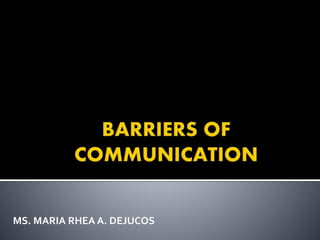Verbal and Non-verbal Communication
•Download as PPTX, PDF•
0 likes•184 views
This presentation talks about the Barriers of communication, the Features of an Effective Communication.
Report
Share
Report
Share

Recommended
Recommended
More Related Content
What's hot
What's hot (20)
LANGUAGE OF RESEARCH, CAMPAIGN, AND ADVOCACIES.pptx

LANGUAGE OF RESEARCH, CAMPAIGN, AND ADVOCACIES.pptx
5. functions of communication and speaker's purpose

5. functions of communication and speaker's purpose
English for Academic and Professional Purposes Teacher's Guide

English for Academic and Professional Purposes Teacher's Guide
DLL SA FILIPINO 11 KOMUNIKASYON AT PANANALIKSIK.docx

DLL SA FILIPINO 11 KOMUNIKASYON AT PANANALIKSIK.docx
Oral Communication in Context Quarter 1 Week 1 Lesson 1.pptx

Oral Communication in Context Quarter 1 Week 1 Lesson 1.pptx
Similar to Verbal and Non-verbal Communication
Similar to Verbal and Non-verbal Communication (20)
Recently uploaded
https://app.box.com/s/x7vf0j7xaxl2hlczxm3ny497y4yto33i80 ĐỀ THI THỬ TUYỂN SINH TIẾNG ANH VÀO 10 SỞ GD – ĐT THÀNH PHỐ HỒ CHÍ MINH NĂ...

80 ĐỀ THI THỬ TUYỂN SINH TIẾNG ANH VÀO 10 SỞ GD – ĐT THÀNH PHỐ HỒ CHÍ MINH NĂ...Nguyen Thanh Tu Collection
Recently uploaded (20)
HMCS Vancouver Pre-Deployment Brief - May 2024 (Web Version).pptx

HMCS Vancouver Pre-Deployment Brief - May 2024 (Web Version).pptx
Exploring_the_Narrative_Style_of_Amitav_Ghoshs_Gun_Island.pptx

Exploring_the_Narrative_Style_of_Amitav_Ghoshs_Gun_Island.pptx
On National Teacher Day, meet the 2024-25 Kenan Fellows

On National Teacher Day, meet the 2024-25 Kenan Fellows
80 ĐỀ THI THỬ TUYỂN SINH TIẾNG ANH VÀO 10 SỞ GD – ĐT THÀNH PHỐ HỒ CHÍ MINH NĂ...

80 ĐỀ THI THỬ TUYỂN SINH TIẾNG ANH VÀO 10 SỞ GD – ĐT THÀNH PHỐ HỒ CHÍ MINH NĂ...
HMCS Max Bernays Pre-Deployment Brief (May 2024).pptx

HMCS Max Bernays Pre-Deployment Brief (May 2024).pptx
Play hard learn harder: The Serious Business of Play

Play hard learn harder: The Serious Business of Play
21st_Century_Skills_Framework_Final_Presentation_2.pptx

21st_Century_Skills_Framework_Final_Presentation_2.pptx
Verbal and Non-verbal Communication
- 1. MS. MARIA RHEA A. DEJUCOS
- 2. BARRIERS OF COMMUNICATION VERBAL AND NON-VERBAL COMMUNICATION
- 3. Explain why there is a breakdown of communication
- 4. USE OF JARGONS/ SEMANTIC NOISE NOISY ENVIRONMENT/ PHYSICAL NOISE EMOTIONAL BARRIERS/ PSYCHOLOGICAL NOISE LACK OF CONFIDENCE/ PHYSIOLOGICAL NOISE
- 5. Worries about money Crashing Deadlines The presence of Specific other people in the room Tight daily schedule Biases related to the speaker or content
- 6. Unique word usage Phrases from foreign Language Mispronunciation Euphemism
- 7. Feeling ill Having a headache Growling Stomach Room is too cold or too hot
- 8. Construction activity Barking dogs Loud music Airplanes Air Conditioners Noisy conflict nearby
- 10. Verbal Communication - refers to an interaction in which words are used to relay a message. For effective and successful verbal communication, use words to express ideas which can be easily understood by the person you are talking to.
- 11. 1. Appropriateness The language that you use should be appropriate to the environment or occasion (i.e., whether formal or informal).
- 12. 2. Brevity Speakers who often use simple yet precise and powerful words are found to be more credible.Try to achieve brevity by being more direct with your words. Avoid fillers and insubstantial expressions which do not add to the message, such as “uh,” “you know,” “I guess,” and others.
- 13. 3. Clarity The meanings of words, feelings, or ideas may be interpreted differently by a listener; hence, it is essential for you to clearly state your message and express your ideas and feelings.
- 14. 4. Ethics Words should be carefully chosen in consideration of the gender, roles, ethnicity, preferences, and status of the person or people you are talking to.
- 15. 5. Vividness -Words that vividly or creatively describe things or feelings usually add color and spice to communication. Hence, you are encouraged to find ways to charm your audience through the use of vivid words.
- 16. Nonverbal communication - refers to an interaction where behavior is used to convey and represent meanings.All kinds of human responses that are not expressed in words are classified as nonverbal communication. Examples of nonverbal communication are stares, smiles, tone of voice, movements, manners of walking, standing and sitting, appearance, style of attire, attitude towards time and space, personality, gestures, and others.
- 17. KINESICS – Body Signals HAPTICS –Touch Signals PROXEMICS – Space Signals CHRONEMICS –Time signals APPEARANCE/ Artifacts – Dress signals ICONICS – Object Signals
- 18. It enhances and emphasizes the message of your speech, thus making it more meaningful, truthful, and relevant. It can communicate feelings, attitudes, and perceptions without you saying a word.
- 19. It can sustain the attention of listeners and keep them engaged in the speech. It gives the audience a preview to the type of speaker you are. It makes you appear more dynamic and animated in your delivery. It serves as a channel to release tension and nervousness.
- 20. It helps make your speech more dramatic. It can build a connection with listeners. It makes you a credible speaker. It helps you vary your speaking style and avoid a monotonous delivery.
- 21. “Communication must be HOT … Honest, Open, andTwo-way” Dan Oswald Thank you